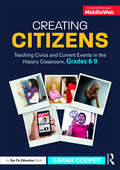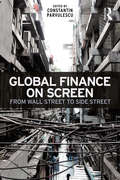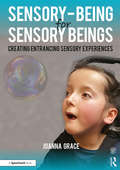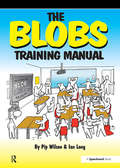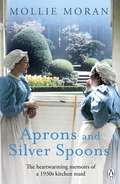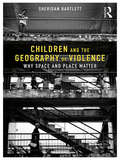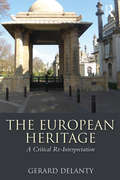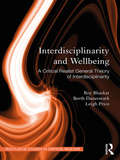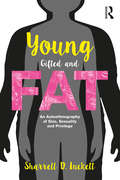- Table View
- List View
Rethinking Urban Transitions: Politics in the Low Carbon City
by Andrés Luque-Ayala Simon Marvin Harriet BulkeleyRethinking Urban Transitions provides critical insight for societal and policy debates about the potential and limits of low carbon urbanism. It draws on over a decade of international research, undertaken by scholars across multiple disciplines concerned with analysing and shaping urban sustainability transitions. It seeks to open up the possibility of a new generation of urban low carbon transition research, which foregrounds the importance of political, geographical and developmental context in shaping the possibilities for a low carbon urban future. The book’s contributions propose an interpretation of urban low carbon transitions as primarily social, political and developmental processes. Rather than being primarily technical efforts aimed at measuring and mitigating greenhouse gases, the low carbon transition requires a shift in the mode and politics of urban development. The book argues that moving towards this model requires rethinking what it means to design, practise and mobilize low carbon in the city, while also acknowledging the presence of multiple and contested developmental pathways. Key to this shift is thinking about transitions, not solely as technical, infrastructural or systemic shifts, but also as a way of thinking about collective futures, societal development and governing modes – a recognition of the political and contested nature of low carbon urbanism. The various contributions provide novel conceptual frameworks as well as empirically rich cases through which we can begin to interrogate the relevance of socio-economic, political and developmental dimensions in the making or unmaking of low carbon in the city. The book draws on a diverse range of examples (including ‘world cities’ and ‘ordinary cities’) from North America, South America, Europe, Australia, Africa, India and China, to provide evidence that expectations, aspirations and plans to undertake purposive socio-technical transitions are both emerging and encountering resistance in different urban contexts. Rethinking Urban Transitions is an essential text for courses concerned with cities, climate change and environmental issues in sociology, politics, urban studies, planning, environmental studies, geography and the built environment.
Natural Hazards: Earthquakes, Volcanoes, and Landslides
by Ramesh Singh Darius BartlettOver the years, the interactions between land, ocean, biosphere and atmosphere have increased, mainly due to population growth and anthropogenic activities, which have impacted the climate and weather conditions at local, regional and global scales. Thus, natural hazards related to climate changes have significantly impacted human life and health on different spatio-temporal scales and with socioeconomic bearings. To monitor and analyze natural hazards, satellite data have been widely used in recent years by many developed and developing countries. In an effort to better understand and characterize the various underlying processes influencing natural hazards, and to carry out related impact assessments, Natural Hazards: Earthquakes, Volcanoes, and Landslides, presents a synthesis of what leading scientists and other professionals know about the impacts and the challenges when coping with climate change. Combining reviews of theories and methods with analysis of case studies, the book gives readers research information and analyses on satellite geophysical data, radar imaging and integrated approaches. It focuses also on dust storms, coastal subsidence and remote sensing mapping. Some case studies explore the roles of remote sensing related to landslides and volcanoes. Overall, improved understanding of the processes leading to these hazardous events will help scientists predict their occurrence. Features Provides information on the physics and physical processes of natural hazards, their monitoring and the mapping of damages associated with these hazards Explains how natural hazards are strongly associated with coupling between land–ocean–atmosphere Includes a comprehensive overview of the role of remote sensing in natural hazards worldwide Examines risk assessment in urban areas through numerical modelling and geoinformation technologies Demonstrates how data analysis can be used to aid in prediction and management of natural hazards
Exploring Natural Hazards: A Case Study Approach
by Darius Bartlett Ramesh SinghThe Sendai Framework for Disaster Risk Reduction 2015–2030 has identified four priority areas for Disaster Risk Reduction: understanding disaster risk; strengthening disaster risk governance to manage disaster risk; investing in disaster risk reduction for resilience and enhancing disaster preparedness for effective response; and to "Build Back Better" in recovery, rehabilitation and reconstruction. Although tremendous progress has been made in recent decades in understanding the workings of the Earth systems and, in particular, its impacts on and responses to human actions, there remains a continuing and pressing need for knowledge that will allow society to simultaneously reduce exposure to global environmental hazards, while also meeting economic development goals. Exploring Natural Hazards: A Case Study Approach, contributes to the knowledge showcasing advanced practices for the monitoring of natural hazards. Through each case study, the book examines mainly hazards arising from processes within the hydrosphere and atmosphere, triggered or exacerbated by inputs to and transfers of energy between environmental components. It discusses the causes of these phenomena, and ways in which improved policy making, sometimes coupled with the application of appropriate modern technologies, can help to reduce people’s exposure to harm. Discussing challenges, lessons learned and recommendations, this book provides a snapshot of issues related to tropical cyclones and typhoons, desertification, floods, lightning as a hazard and the need for alert systems. It is a valuable resource for practitioners and professionals alike, for researchers, students and others who work at the intersection between environmental hazards, sustainable development and social justice.
Creating Citizens: Teaching Civics and Current Events in the History Classroom, Grades 6–9
by Sarah CooperEngage students in meaningful civic learning and encourage them to become active and informed citizens. With this essential book, co-published by Routledge and MiddleWeb, you will gain a variety of practical strategies for teaching civics and current events to your middle school students. Author and expert teacher Sarah Cooper takes you into her school and shares her classroom-tested methods and tools. Topics include: Fitting current events into an already-packed history curriculum Staying nonpartisan and fostering balanced discussions Helping students find their stake in the news Teaching civic literacy through primary sources, then and now Encouraging students to invest in analytical writing Fostering student ownership of our classrooms through discussion and debate Cultivating citizenship through empathy and community engagement Throughout the book, you’ll find student examples, handouts, and rubrics, so that you can easily implement the ideas in your own classroom. By getting your students to think critically about current events, you will help them become passionate writers, thinkers, and involved citizens.
Gender in the 2016 US Presidential Election: Trump, Clinton, and Media Discourse (Global Gender)
by Dustin HarpUsing a discourse analysis, Dustin Harp investigates media during the 2016 US presidential election to explore how traditional (patriarchal) and feminist ideas about gender played out during the campaign. The book illustrates how these two ideologies competed for space and struggled for discursive authority. A broad range of media texts is examined, and "gender moments," where gender became a dominant part of the political conversation, are identified. These include the "nasty woman" and "grab them by the pussy" comments of Donald Trump and the "woman card" played by, and against, Hillary Clinton. Furthermore, Harp reveals how binary notions of gender and stereotypical ideas of how men and women should behave, look, and sound structured the ways Donald Trump and Hillary Clinton were talked about in the media. As a counterpoint, the research also shows the ways feminist ideologies worked against the sexism and misogyny and became mainstream in media discourse during the campaign. Students and researchers of Gender Studies will find that the "gender moments" in Gender in the 2016 US Presidential Election tell a broader story about women, gender expectations, and power. They offer important and timely insights about misogyny and sexual harassment in contemporary US culture and feminist resistance in a mediated public sphere.
Research for the Psychotherapist: From Science to Practice
by Jay L. Lebow Paul H. JenkinsWhile empirical, scientific research has much to offer to the practice-oriented therapist in training, it is often difficult to effectively engage the trainee, beginning practitioner, or graduate student in the subject of research. This fully revised and expanded edition of Research for the Psychotherapist is an engaging, accessible guide that bridges the gap between gathering, analyzing, presenting, and discussing research and incorporating that research into practice. The authors present concise chapters that distill research findings and clearly apply them to practical issues, while also helping readers progress as consumers of relevant research.
International Humanitarian NGOs and State Relations: Politics, Principles and Identity (Routledge Humanitarian Studies)
by Andrew J. CunninghamInternational Humanitarian NGOs and State Relations: Politics, Principles and Identity examines the often discordant relationship between states and international non-governmental organisations working in the humanitarian sector. INGOs aiming to provide assistance to populations suffering from the consequences of conflicts and other human-made disasters work in the midst of very politically sensitive local dynamics. The involvement of these non-political international actors can be seen as a threat to states that see civil war as a state of exception where it is the government’s prerogative to act outside ‘normal’ legal or moral boundaries. Drawing on first-hand experience of humanitarian operations in contexts of civil war, this book explores how the relationship works in practice and how often clashing priorities can be mediated. Using case studies of civil conflicts in Sri Lanka, Darfur, Ethiopia and Chechnya, this practice-based book brings together key issues of politics, principles and identity to build a ‘negotiation structure’ for analysing and understanding the relationship. The book goes on to outline a research and policy development agenda for INGOs to better adapt politically to working with states. International Humanitarian NGOs and State Relations will be a key resource for professionals and policy makers working within international humanitarian and development operations, as well as for academics and students within humanitarian and development studies who want to understand the relationship between states and humanitarian and multi-mandate organisations.
Disaster Management in Australia: Government Coordination in a Time of Crisis (Routledge Humanitarian Studies)
by George CarayannopoulosIn recent times the frequency and severity of natural disasters has placed a clear emphasis on the ability of governments to plan, prepare and respond in an effective way. Disaster Management in Australia examines government coordination when faced with large scale crises, outlining the challenges in managing events such as the 2009 Victorian bushfires and 2011 Queensland floods. The public sector is equipped to deal with policy and service delivery in more routine environments, but crisis management often requires a wider government response where leadership, coordination, social capital, organisational culture and institutions are intertwined in the preparation, response and aftermath of large scale crises. As crises continue to increase in prevalence and severity, this book provides a tangible framework to conceptualise crisis management which can be utilised by researchers, emergency services and government officials alike. Disaster Management in Australia is an important contribution to the study of government coordination of crises and, as such, will be of considerable interest to students and scholars of disaster management, and to policy makers and practitioners looking to refine their approach.
Global Finance on Screen: From Wall Street to Side Street
by Constantin ParvulescuGlobal Finance on Screen is the first collection exclusively dedicated to a growing body of multi-format and multimedia audiovisual work that this book designates as the finance film. Finance film provides critical visualizations of the secretive, elitist, PR firewalled, and gender and race-biased world of finance, and its mysterious characters, jargon and products. It reconstructs for the screen and for broader audiences finance’s logics, responsibilities, practices, and ethos, and traces the effects of money, markets, investment, credit, debt, bubbles, and crashes on our well-being, desires, values, and actions. The chapters for this interdisciplinary collection are written by European and North American scholars in film studies, anthropology, business ethics, cultural studies, political economy, and sociology. They reveal and evaluate the ability of film to document financial cultures; reflect economic, cultural and political transformations related to financialization; indicate the alienating and exploitative consequences of the growing role played by financial services in the global economy; mobilize social action against finance’s excesses; as well as spread finance and capitalist mythology. The collection offers in-depth investigations of feature films such as Wall Street, Freefall, Margin Call, Justice&Co, The Wolf of Wall Street, and The Big Short, and documentaries such as Inside Job, Capitalism: A Love Story and In a Strange Land.
Contract and Procurement Fraud Investigation Guidebook
by Charles E. PiperContract and procurement fraud, collusion, and corruption are worldwide problems. Such wrongdoing causes federal, state, and local governments, as well as private-sector corporations and businesses, to lose funds and profits, while the wrongdoers unjustly benefit. Bid riggers conspire to eliminate fair and open competition and unjustly increase prices, allowing some to monopolize industries. Too often, contracting officials and others responsible for placing orders or awarding contracts compromise their integrity and eliminate fair and open competition to favor vendors offering bribes or gifts. This results in unfair playing fields for vendors and causes financial losses for businesses, government agencies, and taxpayers. Charles Piper’s Contract and Procurement Fraud and Corruption Investigation Guidebook educates readers on fraud and corruption schemes that occur before, during, and after contracts are awarded. This book teaches not only how to identify such wrongdoing, but also how to investigate it and prevent reoccurrence. Piper shares the Piper Method of Conducting Thorough and Complete Investigations, his innovative and proven method of investigating contract and procurement fraud, and demonstrates its principles with personal, on-the-job examples (which he calls "War Stories") woven throughout the text. Intended for criminal justice students, as well as investigators, auditors, examiners, business owners, policy-makers, and other professionals potentially affected by fraud, this book is a must-read guide to effective procurement and contract fraud investigations from inception to testimony.
Policing and Public Management: Governance, Vices and Virtues
by Kevin Morrell Ben BradfordPolicing and Public Management takes a new perspective on the challenges and problems facing the governance of police forces across the UK and the developed world. Complementing existing texts in criminology and police studies, Morrell and Bradford draw on ideas from the neighbouring fields of public management and virtue ethics to open the field up to a broader audience. This forms the basis for an imaginative reframing of policing as something that either enhances or diminishes "the public good" in society. The text focuses on two cross-cutting aspects of the relationship between the police and the public: public confidence and public order. Extending award-winning work in public management, and drawing on extensive and varied data sources, Policing and Public Management offers new ways of seeing the police and of understanding police governance. This text will be valuable supplementary reading for students of public management, policing and criminology, as well as others who want to be better informed about contemporary policing.
Anxiety Management: In 10 Groupwork Sessions
by Robin DynesDesigned for anyone wanting to develop an anxiety management programme for use with groups or individuals, this practical handbook will be invaluable to anyone who is called upon to respond to people who have anxiety problems. It is divided into two parts: information for anxiety management training; and, 10 chapters each looking at specific aspect of anxiety management. This is an invaluable working manual which will help everyone understand anxiety and to explore techniques for successfully controlling it.
A Practical Guide to Helping Children and Young People Who Experience Trauma: A Practical Guide
by Panos VostanisThis will be a concise and practical resource for a range of carers and practitioners working with children who experienced trauma. It will highlight their characteristics in contrast with those for children living in stability, and will describe specific techniques and strategies to help them in different environments and situations. The aim will be to equip practitioners with a range of approaches for these groups of vulnerable children, which are appropriate to sensitively meet their needs and make a difference to their emotional well-being. Key features: case studies; work-sheets; and, evidence-based interventions. It is authored by Dr Panos Vostanis, Professor of Child Psychiatry, University of Leicester; Consultant Child Psychiatrist, Leicestershire Child Mental Health Service.
Social Skills: Developing Effective Interpersonal Communication
by Alex KellyWhat can we do to help those who struggle to develop effective social skills? Social Skills: Developing Effective Interpersonal Communication is a definitive guide to understanding and meeting the needs of those who have difficulty with social skills. Written in a clear and accessible manner, this book provides a theoretical framework to the teaching of social skills alongside a range of practical ideas for practitioners. The book offers a four-step plan that can be adapted for use with young people or adults who are struggling with any aspect of their social skills. A simple model for assessing social skills is provided, as well as ways to measure the impact of intervention. Full of interesting examples and case studies, it includes discussion of how to teach social skills, how social skills develop through childhood, why they sometimes might not, and why social skills difficulties can have an impact on self-esteem and friendships. It includes a breakdown of social skills into the following areas: body language eye contact listening and paralanguage starting and ending conversations maintaining conversations assertiveness Written by one of the most well-known Speech and Language therapists in this field and the creator of the internationally successful Talkabout resources, this book provides a key reference for the study of social skills. It will be essential reading for educators, therapists, parents and anyone supporting others in developing communication and social skills.
Qualitative Inquiry, Cartography, and the Promise of Material Change
by Aaron M. KuntzWhat are the problems to which materialist methodologies are posed as a solution? In this book, Aaron M. Kuntz maps the impact of materialism on contemporary practices of inquiry in education and the social sciences. Through this work, the author challenges readers to consider inquiry as a mode of ethically engaged citizenship with implications for resisting our contemporary moment towards a more equitable future. The author engages his own inquiry as radical cartographic work, drawing forth distinctions between dialectical and dialogic formations of materialism in order to develop what he terms relational materialism—an engaged orientation to living that dwells in the entangled relations of affirmative ethics and enduring practices of resistance and refusal. Drawing upon examples from higher education, contemporary culture, and normative assumptions of governance, the author considers the potential that we might generate living alternatives to the contemporary status quo; daily practices no longer dependent on binary division or standardized calculations of what "matters." As such, the author advocates for practices of virtuous inquiry (future-orientated ethical assertions of what one should do) that orient inquiry as materially ethical activity. Despite the often-overwhelming state of inequity and exploitation in our contemporary world, Kuntz generates an affirmative ethical stance that we can become relationally different, guided by a virtuous determination to articulate inquiry as the cartographic work of disruption and imagination. This text will prove valuable to graduate students and faculty who take inquiry seriously and seek the means to understand their work as engaged in the necessary challenge for material change.
Sensory-Being for Sensory Beings: Creating Entrancing Sensory Experiences
by Joanna GraceSensory-being: the enveloping of natural presentness and awareness in an unfolding sensory moment. Sensory Beings: people whose experience of the world, and meaning within it, is primarily sensory. Often these are people who do not have access to language. If you support someone who understands the world in a primarily sensory way, for example someone with PMLD or later stage dementia, you will recognise that they often face periods of time in which they are left without an activity they can access. This unique, practical guide helps you to plan and deliver sensory activities that lead people into a calm, focused state. You are even invited to let the person you support lead you into a state of sensory focus. Written by a leading sensory specialist this book will help you to: View the world as the person you support may view it, and identify times when a sensory-being activity may be appropriate. Understand how to select and create the most engaging, low cost, sensory foci to suit the specific needs of the individuals in your care. Effectively facilitate sensory-being sessions from start to finish so that the people you care for receive the full and many benefits of calm, focused time. Tried and tested in a diverse range of settings prior to publication, these techniques and practical tools have already helped many people provide an enriched experience of life for those in their care. Throughout the book you will find numerous case studies and insights from parents, carers, special school practitioners, therapists, research institutions and more so that you can benefit from this broad body of experience.
Screening Protest: Visual narratives of dissent across time, space and genre
by Alexa RobertsonScreening Protest brings together a range of scholarly perspectives on the study of protest mediations on television and in film. Arguing that the screen is a fruitful, if overlooked, analytical focus, the book explores how visual narratives of protest wander across borders – territorial, temporal and generic. Chapters compare coverage of major protests in recent history by global news channels like Al Jazeera English, BBC World, CNN International and RT. They consider how geopolitical agendas, newsroom culture and the ubiquity of eyewitness footage shape the narration of events such as the ‘Umbrella Revolution’ in Hong Kong, anti-austerity protests in Greece, pro-EU mobilizations in the Ukraine and clashes in Ferguson. A focus on narrative allows authors to compare such news stories with popular cultural depictions of the protester, in films and television series such as The Hunger Games, Robin Hood and Suffragette. Although focussed on the screen, the scope of the book is broad, given its exploration of images distributed worldwide. Written with both scholars and students in mind, Screening Protest will interest researchers in political science, sociology, media and film studies, as well as the general reader interested in current affairs.
The Blobs Training Manual: A Speechmark Practical Training Manual
by Pip Wilson Ian LongDiscover the full potential of the Blobs! Eagerly awaited, this comprehensive resource book for understanding and using Blobs provides: a fantastic insight into Blobs and Blob Trees, their development and the theory behind them; clear instructions on how Blobs can be used to discuss a wide variety of important issues, emotions or feelings; session ideas and activities for working with groups and individuals of all ages; questions to use with the Blobs; and, what not to do when using Blobs! Ideal for anyone new to the Blobs resources, this manual will also provide background information and additional ideas for those familiar with this engaging series.
Aprons and Silver Spoons: The heartwarming memoirs of a 1930s scullery maid
by Mollie MoranIf you liked Downton Abbey and Upstairs, Downstairs, it's time to discover the reality in Mollie Moran's Sunday Times bestselling memoir, Aprons and Silver Spoons.'If you love Downton, this is right up your street!' Closer 'This evocative memoir... provides a fascinating insight into a world that has long since disappeared' The Sun 'A vivid, entertaining and human glimpse into life in service during the 1930s complete with recipes, tips and photos' My Weekly'a wonderful book' Bookbag'A lovely story' MailonlineWhen young Mollie became a 'skivvy' in a stately London townhouse aged just 14, she quickly learned that a large amount of elbow grease and a sense of humour would be tantamount to surviving there. Through Mollie's eyes we are offered a fascinating glimpse into London's invisible 'downstairs', a world that has long-since vanished: cooking huge roast dinners, polishing doorknobs, scrubbing steps - and covering up her employers' scandals. Going to dances with her fellow servants and flirting with Harrods' errand boys, she had no idea that the oncoming war in 1939 would change her world, and that of those she served, forever...Discover the real hardships and rewards for a pre-war domestic servant in Mollie Moran's charming memoir Aprons and Silver Spoons.Mollie Moran is now ninety-six, living in Bournemouth where she still continues to demonstrate her skills in the kitchen by hosting huge dinner parties. Over eighty years after starting as a scullery maid in London, she still keeps in touch with Flo, the kitchen maid, and her life-long friend.
Children and the Geography of Violence: Why Space and Place Matter
by Sheridan BartlettViolence sabotages development, both children’s development and the development of the communities and neighbourhoods they rely on. There is abundant evidence of the deep and lasting harm that can be done. Violence breaks bodies and minds and exerts an insidious influence at every level. The effects are immediate but can also linger, damaging health, trust and capability, traveling through generations. This book argues that it is impossible to understand the violence in young children’s lives or to respond to it adequately without considering how embedded it is within their physical surroundings. The relations of power that are the context for violence within households, within communities and beyond are often expressed through control over space and the material conditions of life. This book links the abstract concept of structural violence to the stark reality of personal harm, drawing on evidence from a range of disciplines and from countries throughout the global South. It explores the dynamics of cramped, insecure housing, poor water and sanitation, neglected neighbourhoods, forced evictions, cities that segregate the rich and the poor, landscapes of conflict and disaster, and discusses their implications for young children. An alternative approach to child protection is proposed, anchored in the actions of organized communities negotiating to challenge inequities, mend their environments and achieve security. There is a fundamental synergy between building community and protecting children. These are not separate agendas. A place that works for children works better for everyone else as well. This book will be essential reading for all those interested in young children in a global context, whether as child protection professionals, or those with a more general interest in children’s rights issues or in cross cultural approaches to child development. It will also be of great interest to students and researchers of development studies, conflict studies, family studies, child development, public health and urban planning.
The European Heritage: A Critical Re-Interpretation
by Gerard DelantyGerard Delanty offers a critical interpretation of the European heritage today in light of recent developments in the human and social sciences, and in view of a mood of crisis in Europe that compels us to re-think the European past. One of the main insights informing this book is that a transnational and global perspective on European history can reorient the European heritage in a direction that offers a more viable way for contemporary Europe to articulate an intercultural identity in keeping with the emerging shape of Europe, and with its own often acknowledged past. He argues that the European heritage is based less on a universalistic conception of culture than on a plurality of interconnecting narratives. Such a perspective opens up new directions for scholarship and public debate on heritage that are guided by critical cosmopolitan considerations that highlight contention, resistances, competition, and dissonance. He argues that the specificity of the European dimension of culture is in the entanglement of many cultures rather than in an original culture. The cultures of Europe are not separated but have been shaped in close interaction with each other and with the non-European world. Nations are not therefore unique, exceptional, or fundamentally different from each other. The outcome of such intermingling is a multiplicity of ideas of Europe that serve as shared cultural reference points.
Doing Excellent Social Research with Documents: Practical Examples and Guidance for Qualitative Researchers
by Aimee GrantIn today’s society we increasingly create and consume written content and images. This includes a range of sources, from social media posts to records held within organisations, and everything in between, including news articles, blogs, shopping lists and official government documents. Critically reading these ‘documents’ can help us to understand a huge amount about society. Doing Excellent Social Research with Documents includes guidance on how to ‘read between the lines’, and provides an overview of six research projects which use documents as data. The substantive chapters are organised in two sections, with each chapter focused on a specific type of data. Section one focuses on documents that are found in isolation from their authors, including official and historical documents, traditional media, diaries and online content. Section two focuses on using documents in addition to existing data from primary research, including the role of documents in ethnography and visual research methods. In each chapter, you will be guided through the process of: Developing research questions, and how this impacts on which documents are selected; Considering aspects of bias and quality within the documentary sources; Undertaking analysis using six different strategies including thematic analysis, framework analysis, content analysis, discourse analysis and narrative analysis. Drawing on research projects which reflect real world situations, you will be methodically guided through the research process in detail, enabling you to examine and understand the practices and value of a range of documentary analysis approaches. Doing Excellent Social Research with Documents is a practical how-to guide for students (final year undergraduates onwards) and researchers using documents as data.
Interdisciplinarity and Wellbeing: A Critical Realist General Theory of Interdisciplinarity (Routledge Studies in Critical Realism)
by Roy Bhaskar Berth Danermark Leigh PriceIn this book, the authors provide a much-needed general theory of interdisciplinarity and relate it to health/wellbeing research and professional practice. In so doing they make it possible for practitioners of the different disciplines to communicate without contradiction or compromise, resolving the tensions that beset much interdisciplinary work. Such a general theory is only possible if we assume that there is more to being (ontology) than empirical being (what we can measure directly). Therefore, the unique approach to interdisciplinarity applied in this book starts from ontology, namely that there is a multimechanismicity (a multiplicity of mechanisms) in open systems, and then moves to epistemology. By contrast, the mainstream approach, which fails to acknowledge ontology, is “unserious” and tends to result in a methodological hierarchy, unconducive of interdisciplinarity, in which empiricist science is overtly or tacitly assumed to be the superior version of science. This book is primarily aimed at those people interested in improving health and wellbeing – such as researchers, policy-makers, educators, and general practitioners. However, it will also be useful to academics engaged in the broader academic debate on interdisciplinary metatheory.
YoungGiftedandFat: An Autoethnography of Size, Sexuality, and Privilege (Writing Lives: Ethnographic Narratives)
by Sharrell D. LuckettYoungGiftedandFat is a critical autoethnography of "performing thin"– on the stage and in life. Sharrell D. Luckett’s story of weight loss and gain and playing the (beautiful, desirable, thin) leading lady showcases an innovative and interdisciplinary approach to issues of weight and self-esteem, performance, race, and gender. Sharrell structures her project with creative text, interviews, testimony, journal entries, dialogues, monologues, and deep theorizing through and about the abundance of flesh. She explores the politics of Black culture, and particularly the intersections of her lived and embodied experiences. Her body and body transformation becomes a critical praxis to evidence fat as a feminist issue, fat as a Black-girl-woman issue, and fat as an ideological construct that is as much on the brain as it is on the body. YoungGiftedandFat is useful to any area of research or course offering taking up questions of size politics at the intersections of race and sexuality.
At the Mountains’ Altar: Anthropology of Religion in an Andean Community
by Frank SalomonIn high-Andean Peru, Rapaz village maintains a temple to mountain beings who command water and weather. By examining the ritual practices and belief systems of an Andean community, this book provides students with rich understandings of unfamiliar religious experiences and delivers theories of religion from the realm of abstraction. From core field encounters, each chapter guides readers outward in a different theoretical direction, successively exploring the main paths in the anthropology of religion. As well as addressing classical approaches in the anthropology of religion to rural modernity, Salomon engages with newer currents such as cognitive-evolution models, power-oriented critiques, the ontological reworking of relativism, and the "new materialism" in the context of a deep-rooted Andean ethos. He reflects on central questions such as: Why does sacred ritualism seem almost universal? Is it seated in social power, human psychology, symbolic meanings, or cultural logics? Are varied theories compatible? Is "religion" still a tenable category in the post-colonial world? At the Mountains’ Altar is a valuable resource for students taking courses on the anthropology of religion, Andean cultures, Latin American ethnography, religious studies, and indigenous peoples of the Americas.



